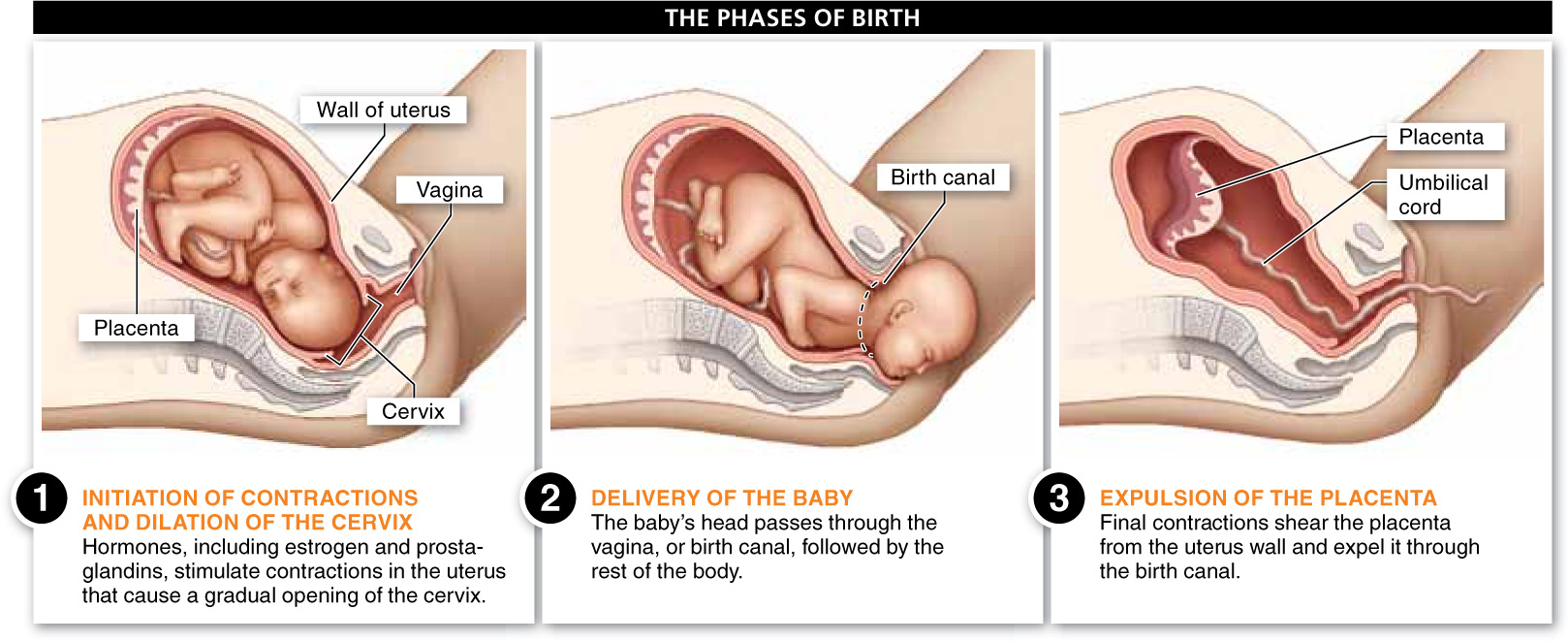Birth, also called parturition, is the culmination of pregnancy, and it occurs in three phases. The first is the initiation of contractions and the dilation, or opening, of the cervix. Toward the end of the third trimester, the fetus usually becomes positioned with its head down and its skull resting on the cervix. This positioning, along with the increasing size of the fetus, stretches the uterus. Although the exact process is not fully understood, fetal hormones cause the placenta to produce hormones, including estrogen and prostaglandin, that stimulate contractions. The stretching of the uterus causes the pituitary gland to release oxytocin, another hormone that causes contractions. The contractions are referred to as labor. The rate of contractions increases from one or two per hour over many hours or even days before the birth, to about one every two to three minutes when birth is about to occur. The contractions cause a gradual dilation of the cervix (FIGURE 25-30).

The second phase of birth is the delivery of the baby through the vagina, which is also called the birth canal. This generally occurs with the head passing first. After delivery of the baby, its umbilical cord is clamped and cut, and clotting quickly stops any bleeding. There is a brief relaxation of the contractions before the third and final phase of the birth process. When the contractions resume, the placenta is sheared from the wall of the uterus and expelled.

1035
How long does breastfeeding last?
During pregnancy, mammary gland development is stimulated by estrogen, progesterone, and other hormones. After birth, the pituitary hormone prolactin stimulates milk production, or lactation. Suckling by the infant, too, causes the release of prolactin and of oxytocin, which further increases milk production. During the first few days, a yellowish fluid, called colostrum, is released. Colostrum is high in protein and contains numerous antibodies from the mother that protect the infant from some diseases (FIGURE 25-31). Gradually, the colostrum is replaced by milk, which is higher in fat and sugar, with less protein than colostrum. The median duration of breastfeeding varies a lot from one country, and one culture, to another. Published reports by the journal Pediatrics and by the World Health Organization, for example, note that the median duration of “any breastfeeding” is approximately 3 months in the United States and 33 to 34 months in Bangladesh and Nepal, respectively.
Can breastfeeding prevent pregnancy?
During lactation, the suckling of the infant prevents the pituitary from releasing a sufficient surge of LH to cause ovulation. For this reason, during lactation, a woman’s fertility is significantly reduced. As a successful method of birth control, this “lactational amenorrhea” depends on several conditions, including that the mother is exclusively breastfeeding (i.e., the baby is not getting nourishment in any other way), the baby is less than six months old, and no more than six hours pass between any two feedings.
TAKE-HOME MESSAGE 25.15
Birth is the culmination of pregnancy and occurs in three phases. The first phase is initiation of contractions and dilation of the cervix. The second is delivery of the baby. The third is expulsion of the placenta. Lactation, stimulated by prolactin and other hormones, nourishes the infant with proteins, carbohydrates, and lipids and provides it with protective antibodies.
What hormones are involved in mammary gland development and milk production during pregnancy and following birth?
During pregnancy, mammary gland development is stimulated by estrogen, progesterone, and other hormones. Following birth, milk production is stimulated by the pituitary hormone prolactin. Suckling by the infant causes the release of the hormones prolactin and oxytocin, which further increases milk production.
1036